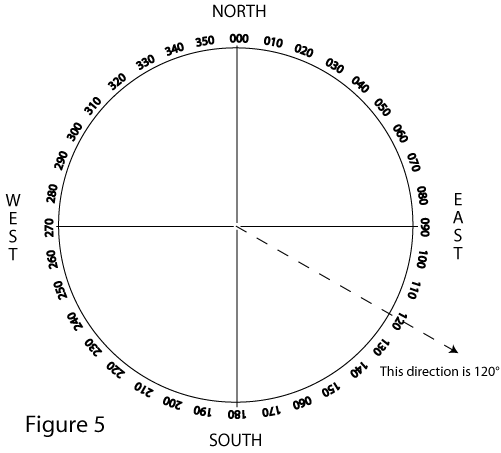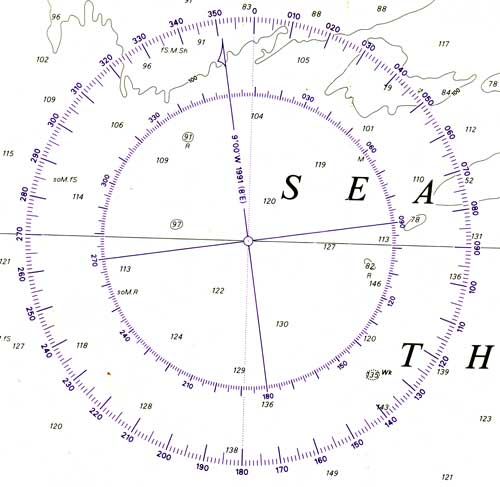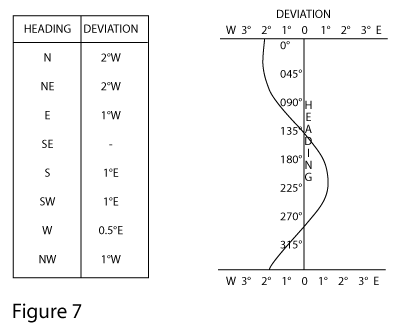1.2 Direction
Measurement of Direction
The next thing we need to find our way from one place to another is a measurement of direction. Once again, this is done by angle.
We are all familiar with the directions North, South, East and West. Years ago directions were expressed by subdividing these into the points of the compass, but this is slightly unwieldy with directions like “south-east by east” and “south-south-east”, so now a simpler method is used and we measure directions in degrees, clockwise from North (see figure 5).
So East is 090°, South 180°, West 270° and North 0°. When saying a direction like 90° we say “zero nine zero” so it can’t be confused with, say, 19°. We still use directions like south-east occasionally, or say “due West” meaning exactly West, or 270°.
The Magnetic Compass
The magnetic compass is one of the most important tools for the navigator, and it has been around for thousands of years. Most people will remember learning about magnets at school.
Very fortunately for navigators, the earth acts as a giant magnet, with the points of magnetic attraction very close to the North and South poles. So the “north-seeking” end of an ordinary magnet will always point to the North if it is allowed to swing freely, provided there are no other magnets or lumps of iron to interfere with it.
Variation
A correction is necessary, however, because the magnetic North pole is not quite in the same position as the earth’s North pole. So the compass points to magnetic North, and this isn’t quite the same as true North (the direction of the North pole). There is generally a difference of a few degrees between the directions of the two Norths.
This difference is called magnetic variation, and it differs according to where you are on the surface of the earth. It also changes with time, but the changes are fairly slow and predictable, so the chart will tell you the magnetic variation for the area you are interested in (see figure 6).


So you simply add or subtract a (small) number of degrees to get from magnetic direction to true direction and vice versa. Variation can be either East or West, and the following examples show how the correction is used:
If variation is 5° WEST:
-
magnetic is always 5° GREATER than true
-
a magnetic compass reading of 105° will convert to a true direction of 100°
-
a true direction of 270° will be a magnetic direction of 275°
If variation is 8 degrees EAST:
-
compass always 8° LESS than true
-
A magnetic compass reading of due North (000°) will convert to a true direction of 008°
-
A true direction of 180° will be a magnetic compass direction of 172°
If your correction takes you "through" north (rare, but much beloved of theory examiners) remember that 368° should actually be 008°, and -5° should actually be 355°. In other words, add or subtract 360.
Not surprisingly, it can be difficult to remember whether to add or subtract the variation correction. One mnemonic to help is:
“Variation is WEST, compass is BEST [i.e. greater number of degrees]
Variation is EAST, compass is LEAST” [i.e. lesser number of degrees]
The compass rose on chart usually (but not always) shows both true and magnetic direction (figure 6) and you can use this to check that you have got the conversion the right way round.
It is generally easier to work in true on the chart (because the edges and lines on the chart are true North/South and true East/West) and convert to and from magnetic when you are working out a course to steer or a bearing you have measured with the compass.
Whenever you write down a direction, write T or M after it to remind you whether it is true or magnetic.
Deviation
A ship’s steering compass may need a further correction known as deviation. This arises because the compass may be close to magnetic materials that cause a small inaccuracy in the way that the compass points.
The size of the deviation error will generally depend on the direction the ship is pointing in. It needs to be measured from time to time, and a “deviation card” will be produced to show the error for each direction of the ship. Figure 7 shows examples of how this might be presented. 
With a hand-held compass you ignore deviation (because it is not used in a fixed position on the boat). Also if deviation is small, it is often ignored.
This error is also stated as East or West, and corrected in exactly the same way as variation, and the same mnemonic rhyme applies.
